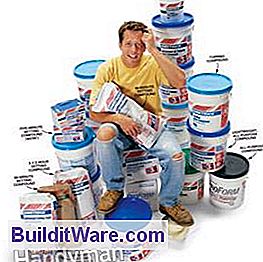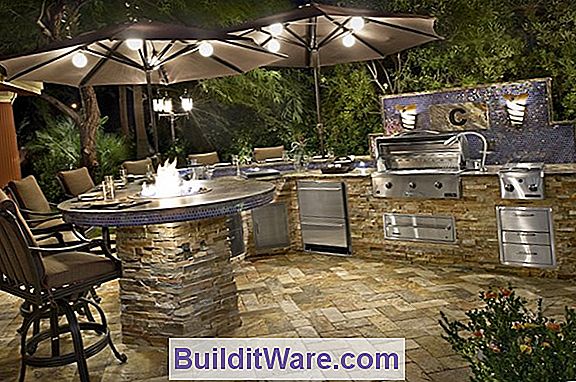Wie wählt man Joint Compound

Den richtigen Typ für Ihr Projekt finden
Einsetzbare Fugenmassen, leichte Fugenmassen, Allzweckmassen und andere haben alle ihren einzigartigen Nutzen. Lerne den Unterschied zwischen ihnen und lerne die verschiedenen Situationen besser kennen.
Welche Fugenmasse wird beim Kleben und Reparieren verwendet

Zu viele Auswahlmöglichkeiten!
Leichtgewichtiger "Allzweck-Trockenbau" und "Easy-Sand" 45-Minuten-Trockenbaumischung sind die beiden Dinge, die Neulinge in ihren Wagen laden sollten. Sie werden Verwendungen für all diese anderen Dinge finden, wenn Ihre Projekte größer werden - und Sie werden schneller und besser.

Abbinden von Compounds
Setzen von Trockenbau-Compounds sind trockene Pulver, die bei Bedarf mit Wasser gemischt werden. Sie verhärten sich in der auf der Tüte angegebenen Zeit.
Für den Anfang, kaufen Sie einen Beutel mit 45 Minuten Einstellung Trockenbau Compound ; Sie werden es in 30 Pfund finden. Taschen (und manchmal kleinere Boxen), mit Namen wie Durabond oder Easy Sand 45. Es kommt wie ein Puder - meist Gips - Sie mischen mit Wasser, wie Sie es brauchen. Es härtet schnell aus (Sie haben es in 45 Minuten erraten), schrumpft sehr wenig und trocknet hart wie ein Stein. Dies macht es ideal zum Füllen von Übergroßenausschnitten um Elektrokästen, Nagel- und Schraubenvertiefungen und Rissen in Bereichen, in denen Trockenbauplatten nicht dicht aneinanderstoßen. Und da es schnell trocknet, können Sie ohne zu warten zum "echten" Tapen übergehen. Kaufen Sie eine "Easy-Sand" -Sorte; das Standardmaterial trocknet so stark, dass man Stunden damit verbringen kann, die von der Kelle hinterlassenen Grate zu schleifen. Stellen Sie sicher, Ihre Werkzeuge aus pronto zu reinigen, wenn Sie fertig sind, es sei denn, Sie möchten eine Skulptur mit dem Titel "Trockenbau-Messer in Pan stecken. "
Zum Einbetten des Bandes und der darauffolgenden Schichten sollten Sie eine leichte, universell einsetzbare Verbindung in dem bekannten (und immer nützlichen) 5-Gallonen-Eimer kaufen. Diese Trockenmasse härtet durch Verdunstung aus - was bedeutet, dass zwischen den Schichten bis zu 24 Stunden gewartet werden muss. Tragen Sie es über die Fugen und an den Ecken voll auf, um das Klebeband einzubetten. Dann verwenden Sie es volle Stärke oder etwas dünner für die oberen Schichten. Versuchen Sie, Grate und Beulen zu vermeiden. Aber wenn Sie sie bekommen, machen Sie sich keine Sorgen. die leichte Verbindung sandt leicht. Es kratzt auch leicht, also nimm so bald wie möglich eine Grundierung darauf. Es ist den extra Dollar pro 5 Gallonen wert, die Sie dafür bezahlen. Ein 5-Gallonen-Eimer wird etwa 450 Quadratfuß von Trockenbau, das Äquivalent von fünfzehn 4 × 8 Blatt.
Was sind die anderen Sachen in den Regalen? Topping-Compounds sind "suppy" und enthalten weniger Klebstoff als Allzweck-Compounds. Dadurch sind sie leicht zu fegen und zu schleifen und somit ideal für die endgültige Beschichtung oder den letzten Anstrich. Einige Profis mögen dieses Zeug, aber für kleine Jobs ist Allzweck gut. Die fünf- und 20-Minuten-Setting Compounds werden von Profis zum Füllen von Zwischenräumen, Bettungsband, manchmal sogar für Decklacke verwendet.Zeit ist Geld für diese Leute; sie können mit schnell härtenden Compounds durchkommen, weil sie wissen, wie man sie schnell und reibungslos mit sehr wenig Schleifen anwendet. Aber wenn du ein Neuling bist, bleib davon frei. Sie werden härter werden, bevor Sie durch den Raum gehen können!
FAQ - 💬
❓ What is the drying time for joint compound?
👉 about 24 hoursHow long does it take joint compound to dry? Under conditions of a temperature of 70° and 70% humidity, joint compound should dry in about 24 hours. Higher humidity and/or lower temperatures will slow drying time.
❓ What is the ratio of water to joint compound?
👉 Setting-Type Compound water or mix with other joint compounds in wet or dry form. If more mixed material is required, use the same ratio of powder to water (2 parts powder to 1 part water). One lb. bag of powder makes 1.3 pints of mixed material.
❓ How much water do you add to premixed joint compound?
👉 Depending on how thick the compound is right out of the box, add approximately 16-32 ounces of water for a full bucket or box. Add it a little bit at a time to see how your mud reacts to adding water. If you are pre-filling your joints with set type compound, then you can run your compound a little thinner.
❓ How do you mix joint compound?
👉 0:502:34Mixing Joint CompoundStart of suggested clipEnd of suggested clipThe drill chuck to make sure the mixer will not slip while it's spinning slowly drop the mixer intoMoreThe drill chuck to make sure the mixer will not slip while it's spinning slowly drop the mixer into the joint compound. Turn on the drill slowly.
❓ Do I have to wait 24 hours for joint compound to dry?
👉 At the far end, drywall mud, also known as joint compound, needs to dry for 24 hours between each coat and before sanding, priming, and painting. The 24 hour drying time recommendation can be applied to nearly all factors.
❓ How many coats of joint compound are needed?
👉 If your wall has distinct crevices, cracks, or textured areas, or if your brand of drywall mud isn't offering enough coverage, you may have to do a couple of additional coats of compound. However, in general, you'll need one coat to fill in the seams and three more coats after taping.
❓ How many coats of joint compound do I need?
👉 Applying Mud You need to lay one layer of mud onto the bare wall to hold the tape, and you can usually lay another immediately after you lay the tape and scrape it. After that coat dries, you topcoat with a third layer, using a wider knife than you used for taping.
❓ Do you need multiple coats of joint compound?
👉 If your wall has distinct crevices, cracks, or textured areas, or if your brand of drywall mud isn't offering enough coverage, you may have to do a couple of additional coats of compound. However, in general, you'll need one coat to fill in the seams and three more coats after taping.
❓ Do you have to use 3 coats of joint compound?
👉 If your wall has distinct crevices, cracks, or textured areas, or if your brand of drywall mud isn't offering enough coverage, you may have to do a couple of additional coats of compound. However, in general, you'll need one coat to fill in the seams and three more coats after taping.
❓ Does joint compound need two coats?
👉 If your wall has distinct crevices, cracks, or textured areas, or if your brand of drywall mud isn't offering enough coverage, you may have to do a couple of additional coats of compound. However, in general, you'll need one coat to fill in the seams and three more coats after taping.
❓ Can I sand joint compound after 12 hours?
👉 At the far end, drywall mud, also known as joint compound, needs to dry for 24 hours between each coat and before sanding, priming, and painting. The 24 hour drying time recommendation can be applied to nearly all factors.
❓
👉 A jointing compound which could be otherwise referred to as drywall compound, mastic, mud or joint cement is a white powdery substance of primarily gypsum dust which when mixed with water forms a mud-like material used with paper or fibre joint tape to seal the joints in between sheets of drywall to enhance painting on the wall of interiors.
❓
👉 Lightweight joint compound is a type of pre-mixed mud that is great for filling in small holes or cracks in a wall. Lightweight mud normally does not have sagging issues after it has dried, which makes it great for patch work.
❓
👉 “ Drywall joint compound ” in the United States (guys in the construction industry call it “mud”) “ Voegenmiddel ” in Dutch, according to one reader – but Elizabeth says the correct translation of joint compound in Dutch is gipsplaatvuller.
❓
👉 Joint compound ( also known as drywall compound or Mastic) is a white powder of primarily gypsum dust mixed with water to form a mud the consistency of cake frosting, which is used with paper or fiber joint tape to seal joints between sheets of drywall to create a seamless base for paint on interior walls.
Autor Des Artikels: Alexander Schulz. Unabhängiger Konstrukteur und technischer Experte. Arbeitserfahrung in der Baubranche seit 1980. Fachkompetenz in den Richtungen: Bau, Architektur, Design, Hausbau.


